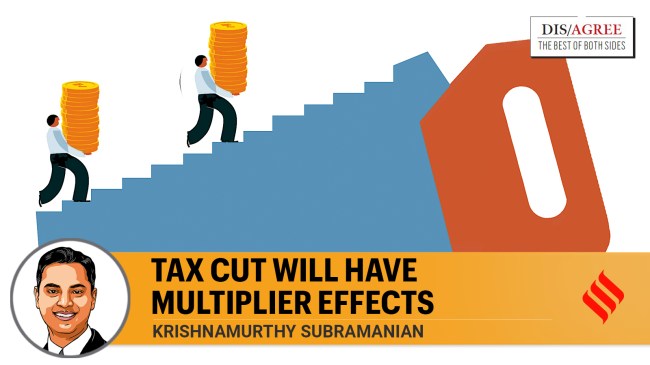Opinion Budget 2025’s tax cuts for middle class will boost consumption many times over
Increased demand from urban middle class will also encourage firms to commit to new projects, crowding in private investment.
 In budget 2025, Finance Minister Nirmala Sitharaman announced unprecedented tax cuts for the middle class. To what extent will these help drive consumption and economic growth? (Illustration by C R Sasikumar)
In budget 2025, Finance Minister Nirmala Sitharaman announced unprecedented tax cuts for the middle class. To what extent will these help drive consumption and economic growth? (Illustration by C R Sasikumar) Budget 2025 has effectively put an extra Rs one lakh crore into the hands of India’s urban middle class by cutting personal income tax (PIT). The question is: What will be the economic impact? Economists use the concept of the consumption multiplier to estimate how extra disposable income can spark multiple rounds of spending and growth. In simple terms, when people have more money, they spend more. The shops and businesses that receive this money then pay their employees and suppliers, who in turn spend more. This chain reaction can multiply the effect of the original amount many times over.
The multiplier hinges on two ideas: (i) The marginal propensity to save (MPS), which is the fraction of each additional rupee that people save; and (ii) the marginal propensity to consume (MPC), which equals the fraction they spend and tautologically equals (1 – MPS). The consumption multiplier equals 1/(1-MPC) and so 1/MPS. To estimate MPS, we note that the debt taken by households, which is included in the net savings rate but not in the gross savings rate, may be used primarily for asset creation. So, to know the proportion of Rs 1 lakh crore that will be consumed, one minus the gross savings rate for the urban middle class represents the best proxy. The gross national savings rate, which is averaged across all Indian households, approximates to 30 per cent for the last decade. This implies a MPC of 0.7 across all households. However, India’s middle class has a higher MPC than wealthy households. The affluent may invest extra income in stocks and real estate, but middle-income earners channel much of any windfall into day-to-day consumption — upgrading phones, buying household items, and spending on education or healthcare. Using the reasonable estimate of 20 per cent as the MPS for urban middle-class households, we obtain a consumption multiplier of five.
The Rs 1 lakh crore tax forego announced by the Finance Minister is a direct transfer to the middle class and therefore a Rs 1 lakh crore increase in their disposable income. Using the consumption multiplier of five, the PIT cut could generate up to Rs 5 lakh crore in additional consumption this year. Usually, the multiplier is lower than that posited by theory because: (i) People might save more if they suspect higher taxes later; (ii) if government borrowing rises, interest rates could climb, dampening private investment; (iii) if consumers buy a lot of foreign goods, the domestic impact drops; (iv) uncertainty about jobs or the economy can push households to save for precautionary purposes; (v) if firms cannot expand production, higher demand might mainly raise prices, not output to match the rising demand.
Currently, urban middle-class spending is lagging rural demand. The PIT cut targets this group precisely, which drives much of India’s consumption of electronics, consumer durables, and entertainment. Many such goods and services are produced locally, so less money leaks abroad. With India’s fiscal deficit under control and consumer confidence holding steady, urban middle-class families will feel comfortable spending now rather than hoarding cash. Tax cuts can sometimes crowd out private investment if the government must borrow more to offset the revenue lost. However, the PIT cut raises demand in the crucial urban middle class, thereby encouraging firms to commit to new projects. More hiring spurs higher incomes, further boosting consumer spending. Instead of crowding out, the well-targeted PIT cut is likely to crowd in private investment.
Real consumption in India stands at Rs 104 lakh crore, and real GDP at Rs 185 lakh crore. Thus, a Rs 5 lakh crore increase leads to consumption growth of 4.8 per cent (five divided by 104), and GDP growth of 2.7 per cent (five divided by 185). Even with a more cautious multiplier of 3.3 — assuming a MPS of 0.30 instead of 0.2 — the bump to consumption and GDP will be equal to 3.2 per cent and 1.8 per cent respectively. Combined with baseline forecasts of 7.2 per cent consumption growth and 6.3 per cent GDP growth, the overall increase is likely to be 10 per cent for consumption and eight per cent for GDP.
The RBI should complement this move by transitioning into easy monetary policy to enable private investment, which will stimulate output growth over several years. Despite the PIT cut, the central government has been fiscally sound, keeping the fiscal deficit at 4.4 per cent of GDP. In fact, as I had predicted last year following the budget, the actual fiscal deficit will be lower than 4.4 per cent of GDP this year too. So, the RBI’s policy stance must lean on fostering private investment and growth now.
Some argue: If tax cuts can create so much new spending, why bother with capital outlays (capex)? The key difference lies in duration. A tax cut is primarily a near-term stimulus; once absorbed this year, it does not yield fresh gains. In contrast, building roads, railways and power infrastructure raises productivity for years, boosting long-term growth. The PIT cut offers a timely spark, but it does not replace the longer-term benefits that arise from public investment. So, I do not anticipate this as a change away from the Union government’s economic policy of growth through a virtuous cycle triggered by investment.
The writer, former chief economic advisor, is executive director at the International Monetary Fund




